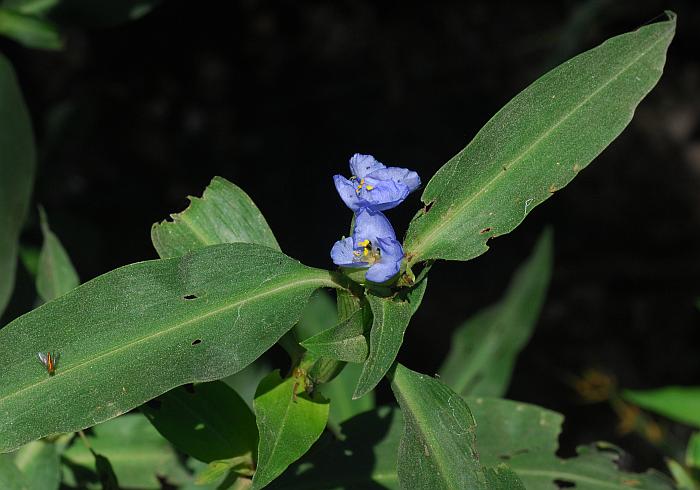Commelina virginica L.
Dayflower

Native
CC = 5
CW = -3
MOC = 41
© SRTurner
Commelina virginica L.Dayflower | |
 |
Native CC = 5 CW = -3 MOC = 41 |
© SRTurner |
|
Family - Commelinaceae Habit - Perennial forb with rhizomes and thickened, fibrous roots. Stems - Erect to ascending, to 1.2 m, sometimes rooting at the lower nodes.
Leaves - Alternate, simple, entire. Blades 8-20 cm long, lanceolate, sometimes somewhat scabrous. Leaf sheaths mostly 1-3 cm long, ciliate with reddish brown hairs, the tips lacking auricles of tissue.
Inflorescence - Mostly clustered near the tips of the stems, sessile or short-stalked, the folded spathelike bracts 20-32 mm long, the margins fused in the lower third, the lower edge (midrib of the bract) curved and noticeably arched or less commonly nearly straight.
Flowers - Sepals 3-5 mm long. Petals 3, somewhat unequal (the lower 1 similar in appearance to the expanded, bladelike portions of the upper 2), the upper 2 petals 11-17 mm long, clawed, blue, the lower petal 9-13 mm long, blue. All 3 staminodes with well-developed false anthers, these 4-6-lobed, yellow, lacking a reddish brown spot in the middle. Stamens 3, 1 of which is incurved and has a longer anther than the other 2, the filaments glabrous.
Fruits - Capsules 4-6 mm long, 2-3-locular and 4-5-seeded. Seeds 3-6 mm long, the surface smooth to slightly granular.
Flowering - July - September. Habitat - Bottomland forests, streambanks, swamp margins, sloughs, ditches. Origin - Native to the U.S. Lookalikes - Other species of Commelina; more broadly, Tradescantia. Other info. - This is the largest species of dayflower found in Missouri. It occurs in the southern half of the state, as well as across the southeastern quadrant of the continental U.S. The plant is easily recognized by its tall stature and flowers having three blue petals and glabrous stamens. The spiderworts (genus Tradescantia) also have blue flowers with three petals, but those flowers have 6 stamens with dense blue hairs on the filaments. The spathelike bracts found in the dayflowers are also absent in Tradescantia. The tawny hairs on the leaf sheaths of Commelina virginica are also unique. The plant is the only rhizomatous species of dayflower in Missouri, though digging up the plant for purposes of identification is frowned upon. Photographs taken in Brown Summit, NC., 7-31-02 (DETenaglia); also at Otter Slough Conservation Area, Stoddard County, MO, 7-31-2015, 8-13-2015, and 8-16-2021; Holly Ridge Conservation Area, Stoddard County, MO, 8-16-2021; and Lower Meramec Park, St. Louis County, MO, 8-15-2022 (SRTurner). |